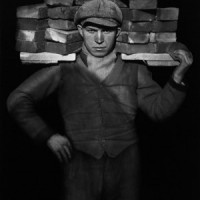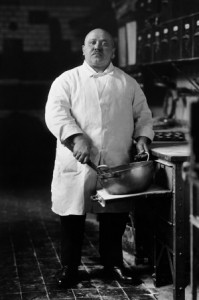
My overwhelming memory of this exhibition is just how big it is. There are over 170 of Sander’s prints on display – including ‘that’ portrait of the pastry chef – so if you had to pay for entry (which you don’t), it’d be excellent value for money. As it is, it makes for a very thought-provoking afternoon. Or morning. I just happened to be there of an afternoon.
My overwhelming impression of this exhibition is of the early 20th century obsession with human ‘type’ that pervaded society and stretched its tendrils into photography as well as any other aspect of life that you could probably mention. Around the same time that Sander was exploring his idea of human ‘type’ in Germany, Hoppe was doing something similar in London: taking photos of people who belonged to specific strata in society, or did particular jobs.

Pastry Chef, 1928, National Galleries of Scotland and Tate. Lent by Antony d’Offay 2010 © Die Photographische Sammlung/SK Stiftung Kultur – August Sander Archiv, Cologne; DACS, London, 2011.
With 170 pictures, you do get to see a lot of ‘types’. Some of them were photographed in the studio, with nothing to suggest their background, whilst others were photographed in their working environment, like the pastry chef, or with clear signs of their trade, like the bricklayer with his hod. If you weren’t told that the subject was ‘An Intellectual’, would you ever know?
That was typical of Sander: he’d title his portraits according to the perceived ‘type’ of person the subject was and we don’t necessarily know their names. Seeing a woman labelled as a ‘Pastor’s Wife’ – defined by her relationship to a man – made me feel extremely uncomfortable. Was this the type of reaction he intended to provoke in his audience? Probably not. But he was a product of his time and I’m a product of mine.
Sander might have wanted to document society and give a picture of the age, but for me, what he has actually succeeded in doing is giving you a very clear insight into his own psyche. These pictures tell you a great deal about him, and the greater sense of the period in which he was living. They don’t, however, tell you an awful lot about the people in them. Whether or not that was how Sander envisaged his oeuvre being received almost 100 years later, I don’t know, but it is interesting all the same.
I didn’t walk away from this exhibition buzzing, but I did enjoy it. If you’re in or around Edinburgh, it’s worth a wander up to the Dean Gallery and an hour or so of your time.
August Sander: People of the 20th Century runs from 12 February to 10 July at the Dean Gallery, 75 Belford Road, Edinburgh, EH4 3DR.
(Featured image: Bricklayer, 1928, National Galleries of Scotland and Tate. Lent by Antony d’Offay 2010 © Die Photographische Sammlung/SK Stiftung Kultur – August Sander Archiv, Cologne; DACS, London, 2011.)





